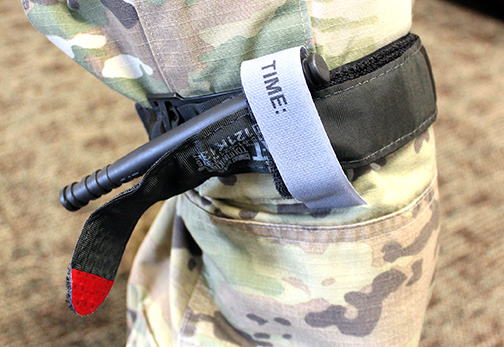Combat Tourniquet Gets Updated Single-Slot Buckle

Deployed Soldiers may receive an updated Combat Application Tourniquet™ and wonder how to use the new version.
Makers of the CAT updated the design of the widely used product, resulting in two different versions currently in use in the field - both with the same National Stock Number (NSN 6515-01-521-7976).
The non-pneumatic CAT, which was developed through research by the U.S. Army Medical Research and Materiel Command, is a small, lightweight tourniquet designed to completely stop arterial blood flow to an injured limb. Every Soldier carries a CAT on the battlefield, allowing troops to provide life-saving care to themself or a fellow Soldier. Exsanguination (e.g., bleeding to death) is the most common cause of potentially survivable death for wounded Warfighters.
The newer version of the CAT, known as "Generation 7," features a single-routing buckle through which Soldiers feed the tourniquet belt before tightening it with the windlass (e.g., textured black rod). The "Generation 6" CAT model has two slots on the buckle and could be used to either double-route (buddy care) or single-route (self-care) the belt.
"When you need to actually use a tourniquet is the wrong time to figure out which version you have and how to use it," said Jason Harrington, the U.S. Army Medical Materiel Agency's nurse consultant in the Medical Devices Program Management Office. "Soldiers need to look at their tourniquets and become familiar with the version they have been issued by carefully reading the printed instructions for use that come with each CAT."
Harrington recommends keeping the instructions for reference and refresher training.
Other identifying differences between the two generations is that the fastener strap on the new model is gray, compared to a white strap on the older model. Additionally, the device's lot number and "G7" are visible on the device and through the manufacturer's packaging.
While the updated CAT single-slot buckle is designed for faster and easier application, the Army emphasizes that both models are effective. Both have been tested by the USAMRMC's U.S. Army Institute of Surgical Research and the Navy. Additionally, Army medics are now trained on both versions.
"Soldiers who have an older version should not feel they have to replace their device by getting the newer version or fear that the older version is any less effective," Harrington added.
The USAMMA, a subordinate agency of the USAMRMC, manages fielding and medical materiel updates to specific Army Sets, Kits and Outfits. The CAT is a single-use item available for order or re-order through standing unit supply channels.














